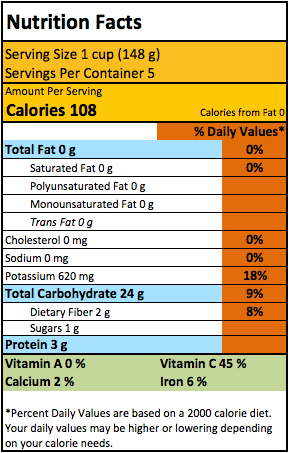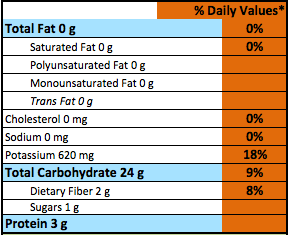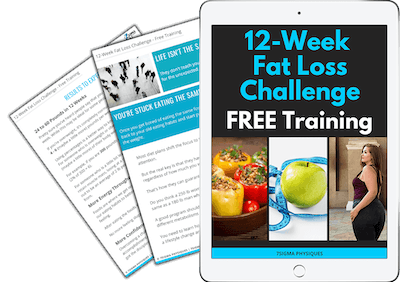Nutrition Labels display detailed information about a food’s nutrient content, such as the number of fats, carbs, protein, vitamins, and minerals.
We will begin by reading the serving size located at the top, then move down to macronutrients, daily values, micronutrients and lastly, ingredients.
Here’s what we’ll cover in this article:
Table of Contents
We’ll use the following example to learn how to read Nutrition Labels.

Note: I’ve highlighted specific sections in this example to make it easier for you to follow along. You won’t find these highlights in the products you buy.
Serving Size, Servings Per Container and Calories

- Serving Size: All nutritional values in nutrition labels are based on this amount. In our example, all values in the label are for 1 cup (or 148 g) of the product.
- Servings Per Container: This is the number of servings of the product that the package contains.
- Calories: Calories are a unit of energy that comes from fats, carbohydrates, protein. There are 108 calories in one serving (1 cup or 148 g) of our sample product.
- 1 g Protein = 4 calories
- 1 g Carbohydrates = 4 calories
- 1 g Fats = 9 calories
Reference guide on what’s considered low, moderate and high calories (1):
- Low: 40 calories.
- Moderate: 100 calories.
- High: 400 or more calories.
The recommended daily calorie intake for an adult female can range from 1,600 to 2,400 calories, while for a male adult it can range from 2,000 to 3,000 calories; however, it’s not uncommon for some people to fall outside of these ranges. (2)
To find how much you should be eating, you can see this guide on how to calculate your macros and TDEE.
Carefully Check the Serving Size and Servings Per Container
You should pay close attention to the Serving Size and the Servings Per Container in a product because it can drastically change the number of calories you think you’re consuming.
Let’s use one Lenny and Larry’s cookie as an example.


There’s only one cookie inside the package, but according to their nutrition labels, there are two servings per container. This means that half a cookie (or 1 serving) has 200 calories and if you decided to eat the whole cookie you’d end up eating double that amount, which is 400 calories.
Macronutrients

These are the nutrients highlighted in blue (fats, carbs, and protein) and are the ones our bodies need in a larger scale, hence the word “macro,” which means “large quantity.”
Fats
Fat helps to absorb fat-soluble vitamins, such as vitamins A, D, E and K. They divide into saturated, polyunsaturated, monounsaturated and trans fat; all the values for the different types of fat are already included in the Total Fat value.
Carbohydrates
Carbohydrates are the body’s preferred source of energy and divide into Fiber and Sugars.
- Fiber
Proper fiber intake is needed for better digestion and gastrointestinal health; however, too much fiber can have adverse effects.
It is recommended to consume 14 g of fiber for every 1,000 calories, with a minimum of 25 g and a maximum of 75 g each day. (3)
- Sugars
Sugars in nutrition labels include naturally occurring sugars (typically found in fruits and milk) and added sugars (dextrose, maltose, sucrose, honey, and corn syrup). You can find these added sugars in the “Ingredients” section.
No recommendation has yet been made about daily sugar consumption; however, overeating added sugars can make it difficult to reach your nutrient goals without going over your calorie goals.
Protein
Protein is a building block for muscles, cartilage, bones, blood, and skin. It is also used to build and repair tissues.
Since protein is not considered a public health concern, products are not required to show a %DV for protein on their nutrition labels.
Start your journey to losing 24-60 pounds in just 12 weeks.
Get the free 12-Week Fat Loss Challenge Training Guide!

Daily Values
Daily values are highlighted in orange and they represent the percentage of the recommended daily value for a nutrient that you get from a serving of the product.
- All percent Daily Values (DV) in Nutrition Labels are based on a 2,000 calorie diet.
- Each percent Daily Value is based out of 100%.
- Percent Daily Values help you identify if food is high or low in a nutrient.
Reference guide of the different percentages (1):
- Low: values under 5%
- High: over 20%
For instance, one serving of our sample product provides 18% of the 100% daily requirement of Potassium. This means that you’d still need another 82% to reach the recommended 100%.
Micronutrients

Micronutrients are the nutrients our body needs in a much smaller scale, hence the word “micros,” and they are usually found at the bottom of nutrition labels.
They are essential for the production and changes in enzyme conditions and also help your body to better utilize nutrients to provide energy and proteins. (4)
Vitamin A, vitamin C, calcium and iron can have positive effects on overall health, therefore, it is recommended to consume as much of the *DV of these nutrients as possible.
A serving of our sample product provides a high amount of Vitamin C at 45%, but a low amount of Calcium at only 2%.
Calorie Free, Fat Free, and Sugar Free Foods
- Calorie Free
A product needs to have less than 5 calories per serving for it to be considered “calorie-free.”
- Fat or Sugar-Free
A product needs to have less than half a gram of fat or sugar to be considered fat or sugar-free. (5)
This means that if you ate 100 servings of a product labeled “calorie, fat or sugar-free” you could be eating a significant amount of calories.
Ingredients
Products that contain more than one ingredient are required to show a list of ingredients. Ingredients will be listed in descending order based on weight, this means that the closer an ingredient is to the beginning of the list, the larger the amount of that ingredient in the product. (6)
This information is useful for individuals with food allergies, vegetarians or people who would like to limit certain ingredients such as added sugars.
Do you have more questions about how to read nutrition labels? Let me know in the comments section below!
If you’re ready to start your weight loss journey, the 12-Week Fat Loss Challenge is the place to start!

This plan helps men and women lose fat without starving themselves or giving up their favorite foods.





